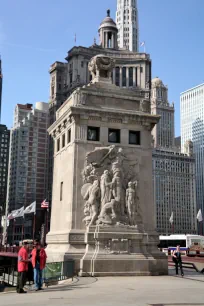The Magnificent Mile, the northern part of Michigan Avenue between the Chicago River and Lake Shore Drive, is Chicago’s version of the Champs-Élysées: a grand wide boulevard with exclusive shops, museums, restaurants and ritzy hotels.





Shopper’s Paradise
All the big names in shopping are present here, from Disney, Apple and Niketown to Bloomingdales and Saks Fifth Avenue. The wide sidewalks, often adorned with well-maintained flowerbeds, are always crowded. The areas around the Magnificent Mile are some of Chicago’s wealthiest.
Landmarks
Architectural landmarks like the John Hancock Center and the Tribune Tower can be found in abundance along the avenue. Building booms in the 1920s, 70s and 90s turned the once low-rise residential street into an economically thriving area bordered by tall skyscrapers.
Michigan Avenue Bridge
Following Daniel Burnham’s plan of 1909, Michigan Avenue was widened to create a thoroughfare able to cope with the growing traffic. In order to connect the avenue with Pine street across the Chicago River, the Michigan Avenue bridge was built in 1920. The beautiful bascule bridge, modeled on the Pont Alexandre III in Paris, allowed traffic to move freely from the busy South Michigan Avenue to the north side of the river, which was renamed to North Michigan Avenue.
Soon after the completion of the bridge, construction on the north side started: in 1920 the Drake Hotel at the northern end and the now famous Wrigley Building at the southern end of N. Michigan Ave. were completed. They were soon followed by other remarkable buildings, including the Allerton Hotel (1924), the Tribune Tower (1925), the Medinah Athletic Club (1929) and the Palmolive Building (1929).
Magnificent Mile

In 1947, when the North Michigan Avenue already had become Chicago’s most fashionable street, real estate developer Arthur Rubloff – who had ambitious plans for the avenue – dubbed North Michigan Avenue ‘Magnificent Mile’. The name stuck, and in 2001 it was even trademarked.
Building Boom
A new building boom started in 1969 with the construction of the John Hancock Center, a 100-story tall residential skyscraper. The tower, situated at the northern end of the avenue, attracted other large buildings, including the nearby Water Tower Place (1976), a tower with more than 100 shops, theaters and restaurants. Another boom started at the end of the 1980s and added some more skyscrapers at the Magnificent Mile, among them the 900 N. Michigan Avenue (1989) and Park Tower (2000).
Old Water Tower
The oldest building along the Magnificent Mile is the Old Water Tower. The tower was built in 1869 and its castle-like architecture looks a bit out of place in this modern high-rise district. One of the lone survivors of the Chicago Great Fire in 1871, the building symbolizes Chicago’s resilience. It faced demolition several times; in 1906, 1918 and 1948, but each time preservationists were able to save the Water Tower.
A Grand Avenue
Thanks to all the landmarks, the wide and beautiful boulevard and the avenue’s great vistas, at the south end bordered by the Michigan Avenue bridge and at its northern end by Oak Street Bridge, the Magnificent Mile is a unique street that you shouldn’t miss on your visit to Chicago.

